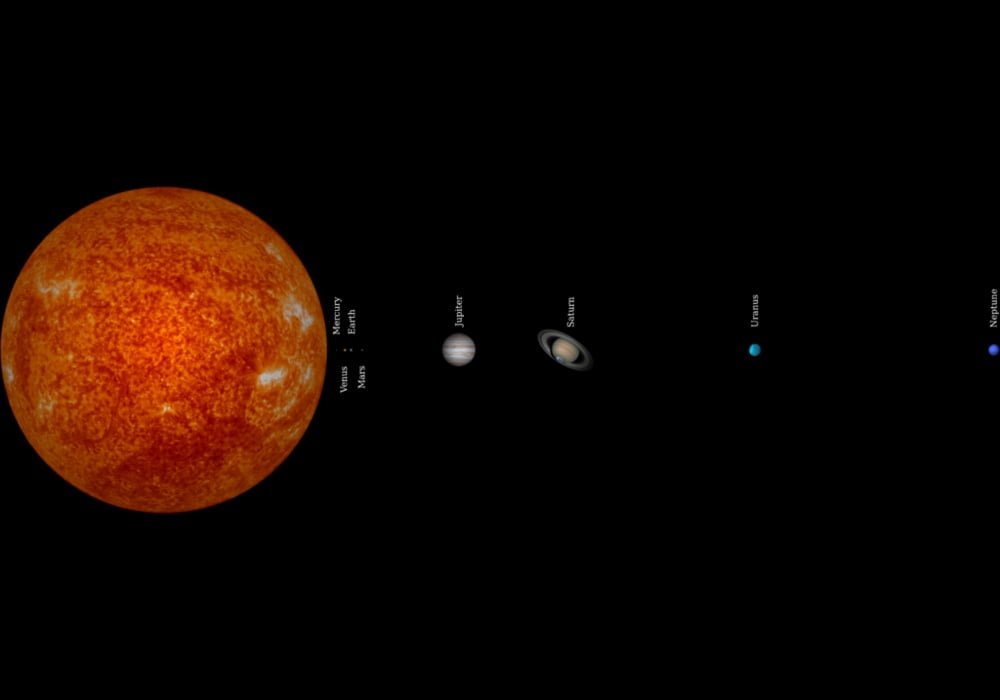Planet Distance to Sun
You must be wondering the planet distance to Sun. The distance between the Earth and the Sun defines the astronomical unit, which is by convention 150 million km (93.2 million miles).
Jupiter, the largest planet, is 5.2 AU from the Sun and has a radius of 71,000 km (44,117 miles), while the farthest planet, Neptune, is approximately 30 AU from the Sun. With a few exceptions, the further a planet or belt is from the Sun, the greater the distance between its orbit and the orbit of the next object closest to the Sun.
Read also: The order of the planets closest to the sun
For example, Venus is about 0.33 AU farther from the Sun than Mercury, while Saturn is about 4.3 AU farther from Jupiter, and Neptune’s orbit is 10.5 AU farther than Uranus. In the past, astronomers have tried to determine a relationship between these orbital distances, notably the Titius-Bode law, but no such theory has finally been validated.
| Planet (or Dwarf Planet) | Distance from the Sun (Astronomical Units miles km) | Period of Revolution Around the Sun (1 planetary year) | Period of Rotation (1 planetary day) | Mass (kg) | Diameter (miles km) | Apparent size from Earth | Temperature (K Range or Average) | Number of Moons |
|---|---|---|---|---|---|---|---|---|
| Mercury | 0.39 AU, 36 million miles 57.9 million km | 87.96 Earth days | 58.7 Earth days | 3.3 x 1023 | 3,031 miles 4,878 km | 5-13 arc seconds | 100-700 K mean=452 K | 0 |
| Venus | 0.723 AU 67.2 million miles 108.2 million km | 224.68 Earth days | 243 Earth days | 4.87 x 1024 | 7,521 miles 12,104 km | 10-64 arc seconds | 726 K | 0 |
| Earth | 1 AU 93 million miles 149.6 million km | 365.26 days | 24 hours | 5.98 x 1024 | 7,926 miles 12,756 km | Not Applicable | 260-310 K | 1 |
| Mars | 1.524 AU 141.6 million miles 227.9 million km | 686.98 Earth days | 24.6 Earth hours =1.026 Earth days | 6.42 x 1023 | 4,222 miles 6,787 km | 4-25 arc seconds | 150-310 K | 2 |
| Jupiter | 5.203 AU 483.6 million miles 778.3 million km | 11.862 Earth years | 9.84 Earth hours | 1.90 x 1027 | 88,729 miles 142,796 km | 31-48 arc seconds | 120 K (cloud tops) | 67 (18 named plus many smaller ones) |
| Saturn | 9.539 AU 886.7 million miles 1,427.0 million km | 29.456 Earth years | 10.2 Earth hours | 5.69 x 1026 | 74,600 miles 120,660 km | 15-21 arc seconds excluding rings | 88 K | 62 (30 unnamed) |
| Uranus | 19.18 AU 1,784.0 million miles 2,871.0 million km | 84.07 Earth years | 17.9 Earth hours | 8.68 x 1025 | 32,600 miles 51,118 km | 3-4 arc seconds | 59 K | 27 (6 unnamed) |
| Neptune | 30.06 AU 2,794.4 million miles 4,497.1 million km | 164.81 Earth years | 19.1 Earth hours | 1.02 x 1026 | 30,200 miles 48,600 km | 2.5 arc seconds | 48 K | 13 |
| Pluto (a dwarf planet) | 39.53 AU 3,674.5 million miles 5,913 million km | 247.7 years | 6.39 Earth days | 1.29 x 1022 | 1,413 miles 2,274 km | 0.04 arc seconds | 37 K | 4 |
Note: Pluto is no longer considered a planet since August 24, 2006.
How many years do you need to drive from the Sun to the following planets?
Good! But let’s move on to more meaningful figures: Let’s take a good car (preferably very comfortable) and travel the Solar System, say at a constant speed of 100 km/h (62.13 mp/h). Starting from the Sun, here are the necessary travel times:
- Mercury 66 years
- Venus 123 years
- Earth 171 years
- Mars 260 years
- Asteroid belt 480 years
- Jupiter 890 years
- Saturn 1600 years
- Uranus 3250 years
- Neptune 5100 years
- Pluto 6800 years
Photo source: Wikimedia Commons
Moon Phases | The Science Behind the Phases of the Moon: How the Moon’s Orbit Affects Its Appearance



